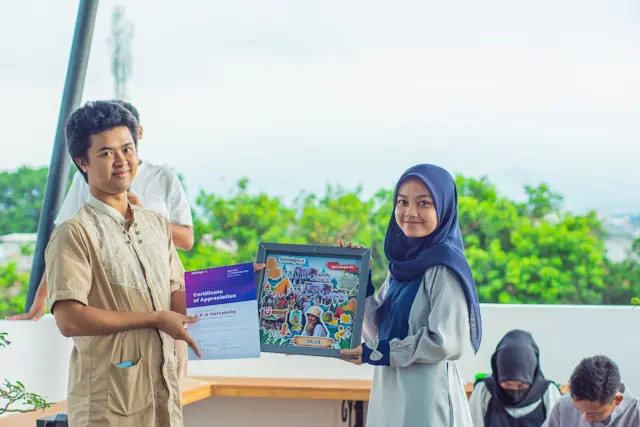
Have you ever dreamed of studying, researching, or teaching in the United States? Do you want to join a prestigious and diverse community of scholars, professionals, and artists from around the world? If yes, then you might want to apply for the Fulbright Scholarship, one of the most renowned and competitive international exchange programs in the world. The Fulbright Scholarship is a unique opportunity for you to pursue your academic and professional goals, as well as to enhance your cultural and personal growth. In this article, I will share with you my personal experience and tips on how to apply for the Fulbright Scholarship in the USA. I will guide you through the whole process, from finding the right program to submitting your application and preparing for the interview. I hope that by the end of this article, you will have a clear idea of what it takes to become a Fulbrighter and how to make your application stand out from the crowd.
What is the Fulbright Scholarship?

The Fulbright Scholarship is a program of the U.S. Department of State that aims to promote mutual understanding and cooperation between the people of the United States and other countries through educational and cultural exchanges. The program was established in 1946 by Senator J. William Fulbright, who believed that international education was a key to world peace and prosperity. Since then, the program has grown to include more than 160 countries and has awarded more than 400,000 grants to participants from various fields and backgrounds. The Fulbright Scholarship is administered by the Bureau of Educational and Cultural Affairs (ECA) of the U.S. Department of State in cooperation with the Institute of International Education (IIE) and other partner organizations.
The Fulbright Scholarship offers different types of programs for different audiences and purposes. Some of the most popular programs are:
- The Fulbright U.S. Student Program, which provides grants for U.S. graduating seniors, graduate students, young professionals, and artists to study, research, or teach abroad for one academic year.
- The Fulbright Foreign Student Program, which enables graduate students, young professionals, and artists from abroad to study and conduct research in the U.S. at U.S. universities or other academic institutions.
- The Fulbright U.S. Scholar Program awards more than 1,700 fellowships each year to U.S. academics and professionals to teach, research, or consult abroad for up to one academic year.
- The Fulbright Visiting Scholar Program brings more than 900 scholars and professionals from abroad to the U.S. to teach, research, or consult at U.S. institutions for up to one academic year.
- The Fulbright Specialist Program sends U.S. experts in various fields to share their knowledge and skills with host institutions abroad for two to six week.
- The Fulbright English Teaching Assistant (ETA) Program places U.S. college graduates and young professionals as English language teaching assistants in schools or universities abroad for one academic year.
Each program has its eligibility criteria, application process, and selection process. You can find more information about each program on the Fulbright Scholar Program website. In this article, I will focus on the Fulbright U.S. Student Program I applied for and received.
Why should you apply for the Fulbright Scholarship?
The Fulbright Scholarship is not just a scholarship; it is a life-changing experience. As a Fulbrighter, you will have the chance to:
- Pursue your academic and professional interests in a different country and culture.
- Learn from and collaborate with leading experts and peers in your field.
- Develop your intercultural and language skills and broaden your global perspective.
- Contribute to the development and improvement of your host community and country.
- Build lasting friendships and networks with people from diverse backgrounds and disciplines.
- Become a part of the Fulbright alumni community, which includes Nobel laureates, Pulitzer Prize winners, heads of state, and leaders in various sectors.
The Fulbright Scholarship is a highly competitive and prestigious award that will boost your resume and career prospects. It will demonstrate your academic excellence, leadership potential, and commitment to public service. It will also open opportunities for further education, research, or employment in the U.S. or abroad.
How do you find the right Fulbright program for you?
The first step to applying for the Fulbright Scholarship is finding the right program. Two main types of grants under the Fulbright U.S. Student Program are the Study/Research grant and the English Teaching Assistant (ETA) grant. The Study/Research grant allows you to design and conduct a project of your choice in a specific country. In contrast, the ETA grant places you as an English language teaching assistant in a school or university in a particular country. You can only apply for one type of grant and one country per application cycle.
To find the right Fulbright program for you, you need to consider the following factors:
- Your academic and professional goals: What do you want to achieve with the Fulbright Scholarship? What kind of project do you want to pursue? How does it relate to your field of study or work? How does it fit into your long-term plans?
- Your personal interests and preferences: What are you passionate about? What kind of country and culture do you want to explore? What kind of challenges and opportunities do you want to face? What kind of skills and experiences do you want to gain?
- Your eligibility and competitiveness: What are the requirements and expectations of the Fulbright program and the host country? How do you meet or exceed them? How do you demonstrate your academic excellence, leadership potential, and public service commitment? How do you stand out from other applicants?
To help you answer these questions, you can do the following:
- Research the Fulbright website and the Fulbright Scholar Program website to learn more about the different programs, countries, and disciplines available.
- Attend webinars, workshops, or information sessions organized by the Fulbright Program, the Fulbright Scholar Program, or your home institution.
- Contact the Fulbright Program Adviser (FPA) at your home institution or the Regional Educational Advising Coordinator (REAC) in your region for guidance and advice.
- Reach out to current or former Fulbrighters in your field or country of interest for insights and tips.
- Read blogs, articles, or books written by Fulbrighters about their experiences and projects.
After doing your research, you should have a clear idea of which Fulbright program and country you want to apply for. You should also have a preliminary proposal or plan for your project or teaching assignment. You are now ready to start your application.
How to start your Fulbright application?
The Fulbright application process is different for each program and country, but it generally consists of the following steps:
- Register online and complete the online application form.
- Write and upload your personal statement and project statement (or statement of grant purpose).
- Request and upload your transcripts and test scores (if required).
- Request and upload your letters of recommendation.
- Request and upload your letter of affiliation (if required).
- Submit your application by the deadline.
You can apply for the Fulbright Scholarship either through your home institution (if it is a Fulbright-affiliated institution) or as an at-large applicant (if it is not). The advantage of applying through your home institution is receiving feedback and support from your FPA and a campus committee, which will review and endorse your application. The disadvantage is that you will have to follow an earlier internal deadline set by your home institution, usually in September or October. The advantage of applying as an at-large applicant is that you will have more time to prepare your application, as you will only have to follow the national deadline set by the Fulbright Program, which is usually in October or November. The disadvantage is that you will not receive any feedback or endorsement from your home institution and will have to compete with a larger pool of applicants.
To start your Fulbright application, you need to do the following:
- Visit the [Fulbright website] and create an account.
- Choose the program and country you want to apply for and read the instructions and requirements carefully.
- Complete the online application form and upload the required documents.
- Request your transcripts and test scores (if required) and upload them.
- Request your letters of recommendation and affiliation (if required) and upload them.
- Review and submit your application by the deadline.
How to write your Fulbright personal statement and project statement?
The most important and challenging part of your Fulbright application is writing your personal statement and project statement (or statement of grant purpose). These are the two essays that will showcase your personality, motivation, qualifications, and potential as a Fulbrighter. They will also demonstrate your fit and feasibility for the Fulbright program and the host country. You need to write these essays carefully and convincingly, as they will be the main basis for your selection or rejection.
The personal statement is a one-page essay that tells your story and explains why you want to be a Fulbrighter. It should answer the following questions:
- Who are you? What are your background, interests, values, and goals?
- Why do you want to be a Fulbrighter? What are your reasons and motivations for applying for the Fulbright Scholarship?
- How do you fit the Fulbright mission and vision? How do you embody the Fulbright qualities of academic excellence, leadership potential, and public service commitment?
- How will you benefit from the Fulbright experience? How will you contribute to the Fulbright community and the host country?
The project statement (or statement of grant purpose) is a two-page essay that describes your proposed project or teaching assignment and explains how it relates to your academic and professional goals, as well as to the Fulbright program and the host country. It should answer the following questions:
- What is your project or teaching assignment? What are your objectives, methods, outcomes, and impacts?
- Why did you choose this project or teaching assignment? How does it align with your field of study or work, your previous experiences, and your future plans?
- Why did you choose this country? How does it fit your project or teaching assignment, your personal interests, and your cultural expectations?
- How will you conduct your project or teaching assignment? How will you prepare, plan, execute, and evaluate your activities? How will you collaborate with your host institution and other relevant stakeholders?
- How will you adapt to the host country? How will you cope with the academic, cultural, and personal challenges and opportunities? How will you engage with the local community and culture?
To write your Fulbright personal statement and project statement, you need to follow these tips:
- Be clear, concise, and coherent. Use simple and direct language, avoid jargon and technical terms, and organize your ideas logically and chronologically.
- Be specific, concrete, and realistic. Provide examples, evidence, and details to support your claims, avoid generalizations and assumptions, and set realistic and achievable goals and expectations.
- Be original, creative, and authentic. Express your own voice, perspective, and personality, avoid clichés and plagiarism, and show your passion and enthusiasm.
- Be positive, confident, and respectful. Highlight your strengths, achievements, and potential, avoid negativity and self-doubt, and acknowledge your limitations and challenges. Respect the Fulbright mission and vision, the host country, and the diversity of opinions and experiences.
- Be consistent, coherent, and complementary. Make sure your personal statement and project statement are aligned and compatible, avoid contradictions and inconsistencies, and show how they complement each other and form a coherent whole.
You can find more information and examples of successful Fulbright personal statements and project statements on the [Fulbright website] or the [Fulbright Scholar Program website]. You can also seek feedback and advice from your FPA, your campus committee, your mentors, or your peers. However, remember that these are your essays and you should write them in your own words and style.
How to prepare for your Fulbright interview?
After submitting your Fulbright application, you will have to wait for a few months to hear back from the Fulbright Program or the Fulbright Scholar Program. If your application is shortlisted, you will be invited for an interview, either in person or online, depending on the program and country you applied for. The interview is the final and decisive stage of your Fulbright selection process, so you need to prepare well and perform well.
The Fulbright interview is a panel interview that usually lasts for 20 to 30 minutes. The panel consists of three to five members, who are usually Fulbright alumni, academics, professionals, or representatives of the Fulbright Program or the Fulbright Scholar Program. The panel will ask you questions about your personal statement, project statement, academic and professional background, and general knowledge and awareness. The panel will also evaluate your communication skills, intercultural skills, and suitability for the Fulbright program and the host country.
To prepare for your Fulbright interview, you need to do the following:
- Review your Fulbright application and refresh your memory on your personal statement, project statement, and other documents. Anticipate possible questions and prepare concise and coherent answers.
- Research the Fulbright program and the host country and update yourself on the latest developments and trends. Be ready to demonstrate your knowledge and interest in the Fulbright mission and vision, the host country’s culture and history, and the current issues and challenges in your field and region.
- Practice your interview skills and techniques with your FPA, your mentors, or your peers. Simulate the interview scenario and get feedback on your performance. Improve your verbal and non-verbal communication, such as tone, volume, speed, clarity, eye contact, posture, and gestures.
- Dress appropriately and professionally for the interview, according to the dress code and culture of the program and country you applied for. Arrive early and be polite to the panel and the staff. Bring a copy of your Fulbright application and other relevant documents, such as your passport, resume, or portfolio.
During the interview, you need to follow these tips:
- Be confident, calm, and positive. Smile, greet, and thank the panel and the staff. Introduce yourself briefly and clearly. Answer the questions honestly and confidently without being arrogant or defensive. Show your enthusiasm and passion for the Fulbright program and the host country.
- Be clear, concise, and coherent. Listen carefully to the questions and ask for clarification if needed. Speak clearly and loudly without mumbling or stuttering. Use simple and direct language, avoid jargon and technical terms, and organize your ideas logically and chronologically.
- Be specific, concrete, and realistic. Provide examples, evidence, and details to support your claims, avoid generalizations and assumptions, and set realistic and achievable goals and expectations.
- Be original, creative, and authentic. Express your voice, perspective, and personality, avoid clichés and plagiarism, and show your passion and enthusiasm.
- Be positive, confident, and respectful. Highlight your strengths, achievements, and potential, avoid negativity and self-doubt, and acknowledge your limitations and challenges. Respect the Fulbright mission and vision, the host country, and the diversity of opinions and experiences.
You can find more information and examples of common Fulbright interview questions and answers on the Fulbright or Fulbright Scholar Program websites. You can also seek feedback and advice from your FPA, mentors, or peers. However, remember this is your interview, and you should answer the questions in your own words and style.
Conclusion
The Fulbright Scholarship is an excellent opportunity for you to pursue your academic and professional goals and enhance your cultural and personal growth. However, applying for the Fulbright Scholarship is not easy; it requires a lot of research, preparation, and dedication. In this article, I have shared my personal experience and tips on applying for the Fulbright Scholarship in the USA. I hope that by following these steps and information, you can craft a solid and successful Fulbright application and become a Fulbrighter. Good luck and all the best!













I am interested
I understand you’re interested in scholarships but prefer not to visit external websites for information. Here’s a general overview to help you get started with finding and applying for scholarships:
1. **Types of Scholarships**:
– **Merit-Based Scholarships**: Awarded based on academic, athletic, or artistic merit.
– **Need-Based Scholarships**: Given to students who demonstrate financial need.
– **Field of Study Scholarships**: For students pursuing specific majors or fields.
– **Demographic-Specific Scholarships**: Targeted towards specific groups (e.g., minorities, women, first-generation college students).
– **Career-Specific Scholarships**: For students aiming for specific careers (e.g., teaching, nursing).
2. **Where to Find Scholarships**:
– **School Guidance Counselor’s Office**: High school students can often find resources here.
– **College Financial Aid Office**: Colleges and universities have lists of available scholarships.
– **Community Organizations and Foundations**: Local clubs, businesses, and charitable organizations often offer scholarships.
3. **Application Process**:
– **Research Early and Thoroughly**: Start looking at least a year before you plan to attend college.
– **Gather Necessary Documents**: This might include transcripts, letters of recommendation, essays, and proof of eligibility (e.g., financial need documentation).
– **Meet Deadlines**: Scholarship deadlines vary widely; keep track of them meticulously.
4. **Tips for Success**:
– **Tailor Your Application Essays**: Make sure each essay matches the scholarship’s criteria and speaks directly to the organization’s goals.
– **Stay Organized**: Keep a calendar or spreadsheet with all deadlines and requirements.
– **Apply Widely**: The more scholarships you apply for, the better your chances.
Let me know if you want more detailed information on any specific type of scholarship or need advice on how to approach a particular part of the application process!